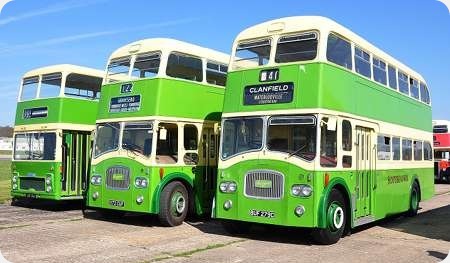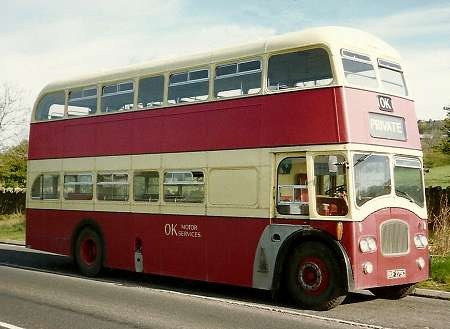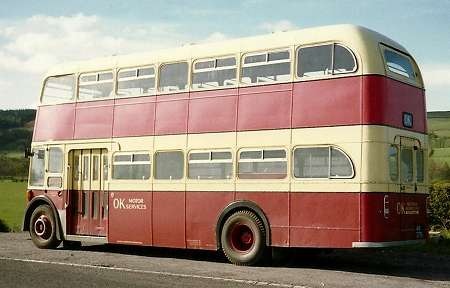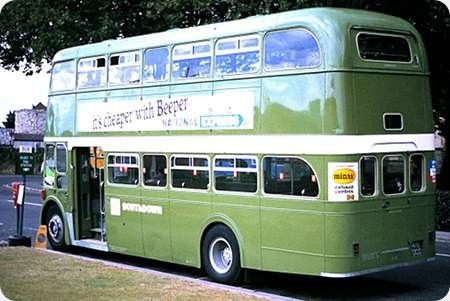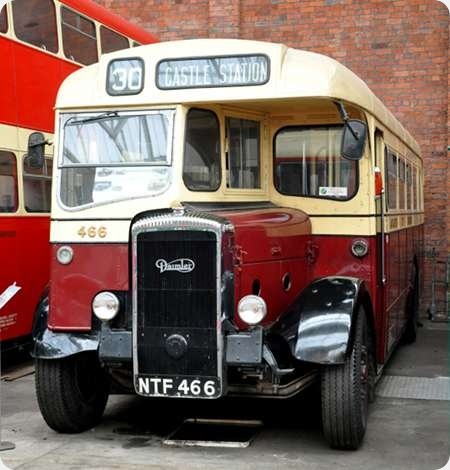
Lancaster City Transport
1952
Daimler CVG5
Northern Counties B35F
NTF 466 is a Daimler CVG5 with Northern Counties B35F body, built for Lancaster City Transport in 1952. There were three of them, but 467 and 468 were withdrawn in 1958. They had B32R bodies [with door!] when new and 466 was converted in the operator’s workshops to forward entrance layout in 1958. Now restored to her original livery, she carried Trafalgar Blue and White for a time after the ‘shotgun marriage’ of Lancaster and the adjacent Borough Of Morecambe & Heysham in 1974. [The other three Councils involved – Carnforth Urban District, Lancaster Rural District and Lunesdale Rural District – didn’t seem to object anywhere near so much, but Lancaster and Morecambe & Heysham had never ‘got on’.] She was retained for so long after her sisters for a very simple reason. Her 7ft 6in body was narrow enough to fit through the gateway of Lancaster Castle. Most of the place had been used as a prison for many years and this was the last vehicle in the fleet capable of taking the inmates to the prison’s farms. She is seen in the museum in St Helens on 15 August 2012, and the adjacent information board tells us she was known – for fairly obvious reasons – as ‘the prison bus’.
Photograph and Copy contributed by Pete Davies
10/05/15 – 16:28
A beauty, looking good. Would have loved the big old CAV headlamps (if indeed she once had them) but you can’t have everything! I can’t spot the date she actually retired- was it a record?
Am I right to wonder if she also got one of those neck-cricking OMO "squint" windows to the cab when the door was moved?
Joe
10/05/15 – 16:49
I believe it was withdrawn in 1977 but kept as a keepsake until the end of LCT in 1993
Paul Turner
11/05/15 – 07:12
I quote from a former employee of LCT, Richard Allen, who supplied me with much information about the company which enabled me to provide a fleet list for this site: "NTF 466 was new as B36R just like NTF 467/8. It was rebuilt to B32F for OPO from 01/58 and in 06/1970 it was upseated to 35 in connection with the prison contract which it worked. It was considered too slow and laborious for OPO when underfloor engined buses were arriving, so 467/8 were never considered for conversion and were sold at the end of 1958".
It doesn’t answer your question, Joe, about windows, but if it did acquire something different it doesn’t sound like it was used for very long!
Dave Towers
11/05/15 – 07:12
Am I right in thinking that Trafalgar blue wasn’t the first choice of the "transport department" – didn’t they plump for a maroon colour with "City of Lancaster" fleetname to start with? I think the blue livery/Lancaster City Council fleetname was the result of a decision to adopt a "house-style" across the Council.
Philip Rushworth
12/05/15 – 06:57
Philip, In the early days of the merged operation, both sides kept their old colours with CITY OF LANCASTER in Tilling style as the fleetname. I have photographs of both backgrounds with that name. Certainly, the Trafalgar blue and white appeared to be the "house style" which came in fairly quickly.
Pete Davies
14/05/15 – 07:19
There was a good article in the February-March issue of ‘Classic Bus’ on the Lancaster-Morecambe & Heysham merger. It is written by Thomas Knowles who was GM of the combined undertaking from the outset and he outlines the problems he had with bringing the two former operations together. It contains plenty of good photographs.
Philip Halstead
This bus was repainted in Trafalgar blue in 1977 as part of the Queen’s Silver Jubilee celebrations and ran a service along Morecambe seafront over that summer its prison bus replacement was a Tiger Cub with single door East Lancs bodywork.
A friend who was a management trainee with Lancaster once told me that this bus also survived so long because the prisoners could not overpower the driver in his separate cab!
Chris Hough
12/12/16 – 06:38
As a belated update on this vehicle it was also fitted with a rear facing seat at the front so the guards could watch the prisoners. It has problems with its brakes which is why it is not in current use, however there are plans for it to be repaired and returned to the road for 2017.
It is a fine looking vehicle and should be very popular on the free bus running days at the Northwest Transport museum in St Helens.
John P
13/12/16 – 07:15
Do I interpret, from your info, Pete, that the two Rural District Councils ran buses? If so, they’re the first I’ve come across.
Chris Hebbron
13/12/16 – 09:38
No, Chris. Only Lancaster City and Morecambe & Heysham Borough ran buses (trams previously). The two RDCs relied on Ribble and while Carnforth UD had no bus operations, it was the northern terminus of M&H service 73 which was operated jointly with Ribble. This was in addition to Ribble services passing through.
I meant in my original copy that the two Councils never ‘got on’. The remarks by each about the other were little short of hatred, very much like the supporters of one football club say about the supporters of their neighbours. Portsmouth and Southampton, Aston Villa and Birmingham City, or Manchester City and Manchester United, for example!
Pete Davies
13/12/16 – 14:16
Sorry, Chris H, I must insist, the replacement for 466 on the prison work was not a Tiger Cub but one of the dual-doorway Leopards, the batch being 101-103 (101-103 UTF). I don’t recall ever seeing a Tiger Cub on prison duties.
What I can’t now remember, for sure, is whether one of the Leopards was used consistently, or whether all were used in turn, but if I had to guess, I would say it was the former.
David Call
15/12/16 – 13:55
Pete D, I think you must have rushed that last comment, since I’m sure that if you’d thought about it you would have realised that what you were saying wasn’t quite correct. Service 73 was essentially Ribble service 73, since, throughout the period of service 73’s existence, M & H did not themselves use route numbers. As to whether it being Ribble service 73 also made it M & H service 73, irrespective of M & H not making a point of using route numbers, let alone displaying them on vehicles, I wouldn’t like to say. We’d probably need a contemporary M & H timetable to determine that one.
Sometime in the mid-1960s, as part of a Ribble policy of renumbering its Northern area services as 5xx or 6xx, service 73 became service 573. Not long afterwards (I’m not sure exactly how long, though) M & H received its first AEC Swifts, 1-6 (CTJ 101-6E). These were intended to be used OPO from the word go, and one of the routes they went on was Morecambe-Carnforth, upon which they displayed the number 573. Unfortunately, because the rest of the M & H routes were at this time still unnumbered, there was no great incentive for drivers to wind off the 573 display, so M & H’s other OPO routes seemed to become ‘573’! In due course (I think it was around 1970) M & H did introduce its own route numbering system.
Interestingly, when the M & H journeys on Morecambe-Carnforth went OPO, the Ribble-operated ones remained crew-operated, and this situation remained for about twelve months. In a company/municipal situation, you would have thought it would be the company which would be the first in with OPO.
David Call
16/12/16 – 06:24
Yes, Mr Call, you are of course correct. Apologies to the readership for any confusion. I’ll go back to sleep!
Pete Davies
